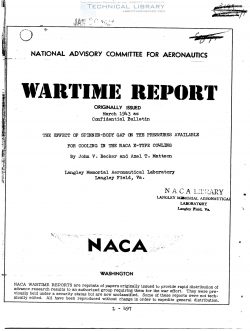naca-wr-l-497
- Version
- 134 Downloads
- 463.43 KB File Size
- 1 File Count
- April 2, 2017 Create Date
- April 2, 2017 Last Updated
The Effect of Spinner Body on the Pressures Available for Cooling in the NACA E-Type Cowling

By John V. Becker and Aral T. Hattson
SUMMARY
Tests of a l/3—sca1e model of an NAGA E—type cowling
were made in the vioot high—speed tunnel for the purpose
of determining the effect of the gap between the skirt of
the hollow spinner and the cowling pr0per on the pressures
available for cooling. It was found that even a large gap
(0.096 in. on the model) had no appreciable effect on the
available cooling pressures.
INTRODUCTION
The NASA type—E cowling has a hollow spinner through
which the engine cooling air is admitted. The propeller
hub and blade shanks are covered by an inner spinner and
fairings that also serve to provide blower action for the
ground and climb cooling conditions. A principal charac—
teristic of the cowling is its external shape, which per—
mits the attainment of very high critical compressibility
speeds, provided an inlet velocity of 0.4 free stream ve—
locity or greater is maintained. The external lines of
the cowling were obtained from nose shape 3 of reference
1. Models of this type of oowling were designed and
tested in the investigations described in references 2
and 3. A photograph showing the general arrangement of
the N—cowling spinner employed in the present tests.is
shown in figure 1. I
Two general methods hays been suggested for design—
ing the spinner-body gap for the E cowling. In one method
the gap is made very small and the flow passage is re—
stricted by seals or labyrinths in order to reduce the air
flow to a minimum. This design obviously presents manu—
facturing difficulties and the flow restrictions cause
energy losses in the gap flow. In the second method the
gap is designed as an aerodynamically efficient air out—
let, shaped to make both the internal and external flow
losses at the gap as small as possible. As no attempt is
made to keep the gap size very small and no restrictions
are placed in the path of the flow, this design is simple
to manufacture. This second arrangement, however, has
been questioned on the grounds that the presence of a
relatively large unobstructed gap might adversely affect
the pressures available for cooling in the main body of
flow. The present investigation was therefore undertaken
to determine the effect of gap size on the available
cooling pressures.
The effects of gaps of two sizes on the pressures
available for cooling were measured. For comparison the
pressures available with gap sealed were also determined.
The data are analyzed and discussed in some detail with
the intention of clearing up several misconceptions that
have existed regarding the effects of the gap.
SYHBOLS
A area
B total pressure
AH loss in total pressure across Spinner
V velocity of air stream
n propeller rotational Speed
D prepellor diameter
p air density
1 .
q dynamic pressure Epr}
GT thrust coefficient {ihll%il
PnaD /
q ' flew quantity
Subscripts:
0,1,2 stations in flow system shown in figure 2
g condition with gap open
s condition with gap sealed
=Ill-
'__'__'_' 14
.-n .w . ILOW RELATIONS
Tigure 2 represents the streamlines of the flow
entering the cowling for the gap—open and gap—sealed
conditions. Inasmuch as the flow quantity required for
engine cooling is the same for each case, the stream—
tube area (A0 on fig. 2) far ahead of tho.cow1ing cor—
responding only to the cooling—air flow must be the same
for each gap condition. It is shown in reference 4 that
the pressure built up at station 2 in front of the engine
depends solely on the ratio Ao/Aa for a given flight
speed and diffuser loss. In the case of the present
tests, this ratio is constant for all gap openings and
the pressures available at station 2 will thus be the
same regardless of gap size. Any effect of the gap on
the pressure at station 2 must therefore arise from one
of the following secondary considerations, which were
neglected in the tests of reference 4.
l. The total flow quantity in the spinner is greater
for the gap—open case because of the flow through the gap.
The skin—friction and diffuser losses within the spinner
will thus be somewhat greater with the gap open.
2. The suction of air through the gap could conceiv—
ably improve the diffuser efficiency of the spinner
through a favorable boundary—layer control action.
The increased spinner—diffuser loss with the gap
open (item 1) can be evaluated on the assumption that the
spinner losses vary as the square of the flow quantity.
That is,
3
Effects due to suction of the boundary layer through
the gap (item 2) can be evaluated only by experimental
methods. '
| File | Action |
|---|---|
| naca-wr-l-497 The Effect of Spinner Body on the Pressures Available for Cooling in the NACA E-Type Cowling.pdf | Download |

Comment On This Post